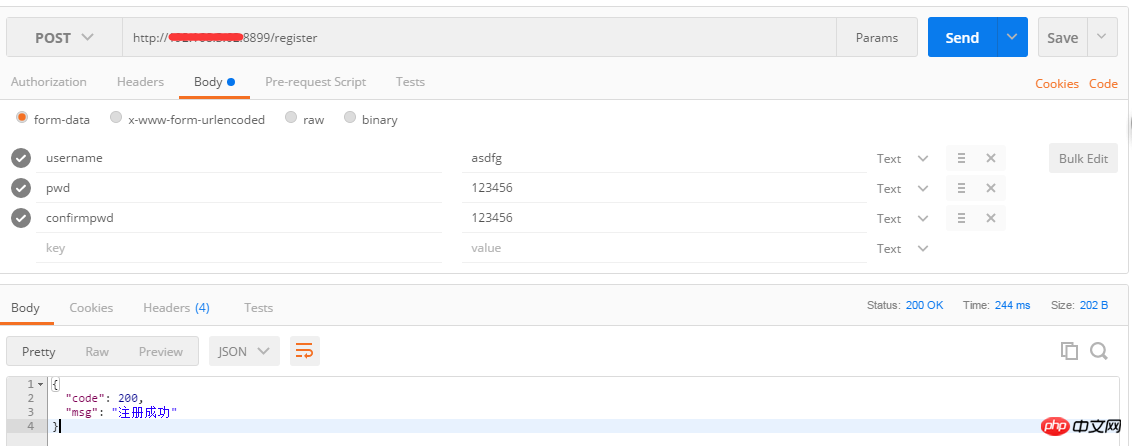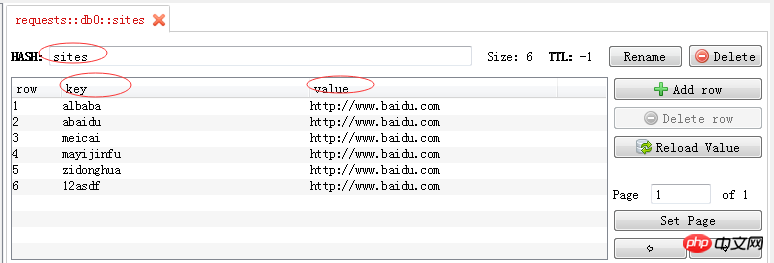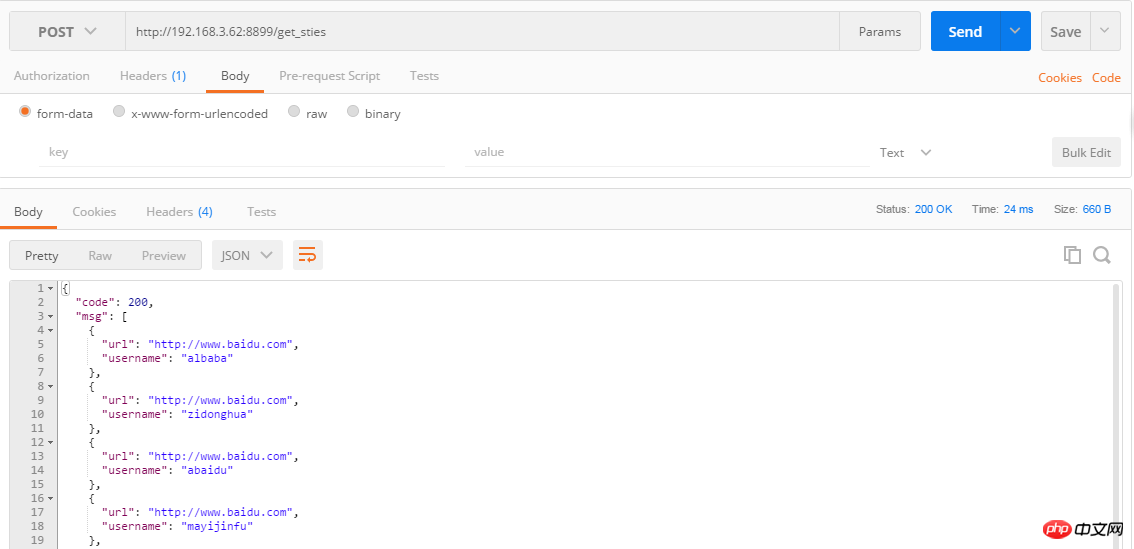
Let’s briefly talk about interface testing. The two commonly used interfaces are http api and rpc protocol interfaces. Today we mainly talk about: http apiInterface It uses the http protocol to distinguish calls through paths. The request message format is in the key-value format, and the return message is generally a json string;
Interface protocol:http, webservice, rpc, etc.
Request method: get, post method
Request parameter format:
a. Get requests are all through url?param=xxx¶m1=xxx
b. Common types of request parameters for post requests are: application/json, application/x-www-form-urlencoded, multipart/form-data, text/html, etc.
You also need to know the url of the interface, parameter type, data format of the returned result, and whether the interface has header, cookie and other information.
1 import flask
2 from flask import request
3 from flask import jsonify
4 import tools
5 import OP_db
6 import settings
7 '''
8 flask: web框架,可以通过flask提供的装饰器@server.route()将普通函数转换为服务
9 登录接口,需要传url、username、passwd
10 '''
11 #创建一个服务,把当前这个python文件当做一个服务
12 server = flask.Flask(__name__)
13 #server.config['JSON_AS_ASCII'] = False
14
15 # @server.route()可以将普通函数转变为服务 登录接口的路径、请求方式
16 @server.route('/login', methods=['get'])
17 def login():
18 # 获取通过url请求传参的数据19 username = request.values.get('name')
20 # 获取url请求传的密码,明文
21 pwd = request.values.get('pwd')
22 # 判断用户名、密码都不为空,如果不传用户名、密码则username和pwd为None
23 if username and pwd:
24 # 获取加密后的密码
25 password = tools.md5_pwd(pwd)
26 #执行sql,如果查询的username和password不为空,说明数据库存在admin的账号
27 sql = 'select name,password from test where name= "%s" and password= "%s";' %(username, password)
28 # 从数据查询结果后,res返回是元组
29 res = OP_db.getconn(
30 host=settings.mysql_info['host'],
31 user=settings.mysql_info['user'],
32 passwd=settings.mysql_info['pwd'],
33 db=settings.mysql_info['db'],
34 port=settings.mysql_info['port'],
35 sql=sql
36 )
37 if res: #res的结果不为空,说明找到了username=admin的用户,且password为加密前的123456
38 resu = {'code': 200, 'message': '登录成功'}
39 return jsonify(resu) #将字典转换为json串, json是字符串
40 else:
41 resu = {'code': -1, 'message': '账号/密码错误'}
42 return jsonify(resu)
43 else:
44 res = {'code': 999, 'message': '必填参数未填写'}
45 return jsonify(res)
46
47 if __name__ == '__main__':
48 server.run(debug=True, port=8888, host=0.0.0.0) #指定端口、host,0.0.0.0代表不管几个网卡,任何ip都可以访问md5 encryption, For details on the operation of the database mysql, please see my other blogs~~~~~
After the project is started, the address of the interface is: http ://127.0.0.1:5000/, the default port is 5000.
Open the browser, enter the url http://127.0.0.1:5000/xxx?name=xxx&pwd=123456, followed by the interface address login, and use the parameters and url directly? Connected, each request parameter is directly connected using &. If the request is successful, {'code': 200, 'message': 'Login successful'} will be returned.
1 import flask
2 from flask import jsonify
3 from flask import request
4 from conf import opMysql
5 from conf import md5_create
6 '''
7 注册接口:
8 post请求,请求参数入参类型json
9 {
10 "username":"aaa",
11 "pwd":"123456",
12 "c_pwd":"123456"
13 }
14 '''
15 server = flask.Flask(__name__)
16 @server.route('/register', methods=['GET', 'POST'])
17 def registerPost():
18 #判断接口的请求方式是GET还是POST
19 if request.method == 'POST':
20 # 获取请求参数是json格式,返回结果是字典
21 params = request.json
22 username = params.get('username')
23 pwd = params.get('pwd')
24 confirmpwd = params.get('confirmpwd')
25 if username and pwd and confirmpwd: # 判断输入的用户名、密码、确认密码都不为空
26 select_sql = 'select username from lhldemo where username = "%s" ;'%username
27 # 查询注册的用户是否存在数据库,如果存在,则username不为空,否则username为空
28 res_mysql = opMysql.op_select(select_sql)
29 if res_mysql:
30 return jsonify({"code": 999, "mesg": "用户已注册"})
31 else:
32 if pwd == confirmpwd: # 判断pwd和confirmpwd一致
33 new_pwd = md5_create.md5_test(pwd) # 加密后的密码
34 insert_sql = 'insert into lhldemo(username,password) values("%s", "%s") ;' % (username, new_pwd)
35 opMysql.op_insert(insert_sql)
36 return jsonify({"code": 200, "msg": "注册成功"})
37 else:
38 return jsonify({"code":998, "msg":"密码不一样"})
39 else:
40 return jsonify({"code": 504, "msg": "必填项不能为空"})
41 else:
42 return jsonify({"code": 201, "msg": "请求方式不正确"})
43
44 if __name__ == '__main__':
45 #port可以指定端口,默认端口是5000
46 #host写成0.0.0.0的话,其他人可以访问,代表监听多块网卡上面,默认是127.0.0.1
47 server.run(debug=True, port=8899, host='0.0.0.0')After the project is started, the interface address is: 127.0.0.1:5000/, the default port is 5000.
Open the browser, enter the url http://127.0.0.1:5000/xxx, followed by the interface address register, use postman or jmeter to request the parameters, and the parameter type is json. If the request is successful, {'code': 200, 'message': 'Login successful'} will be returned.
1 import flask
2 from flask import jsonify
3 from flask import request
4 from conf import opMysql
5 from conf import md5_create
6 '''
7 注册接口:
8 post请求,请求参数入参类型json
9 {
10 "username":"aaa",
11 "pwd":"123456",
12 "c_pwd":"123456"
13 }
14 '''
15 server = flask.Flask(__name__)
16 @server.route('/register', methods=['get', 'post'])
17 def registerPost():
18 #post请求获取请求的参数,返回结果类型是str
19 username = request.values.get('username')
20 pwd = request.values.get('pwd')
21 confirmpwd = request.values.get('confirmpwd')
22 if username and pwd and confirmpwd: # 判断输入的用户名、密码、确认密码都不为空
23 select_sql = 'select username from lhldemo where username = "%s" ;'%username
24 # 查询注册的用户是否存在数据库,如果存在,则username不为空,否则username为空
25 res_mysql = opMysql.op_select(select_sql)
26 if res_mysql:
27 return jsonify({"code": 999, "mesg": "用户已注册"})
28 else:
29 if pwd == confirmpwd: # 判断pwd和confirmpwd一致
30 new_pwd = md5_create.md5_test(pwd) # 加密后的密码
31 insert_sql = 'insert into lhldemo(username,password) values("%s", "%s") ;' % (username, new_pwd)
32 opMysql.op_insert(insert_sql)
33 return jsonify({"code": 200, "msg": "注册成功"})
34 else:
35 return jsonify({"code": 998, "msg": "密码不一样"})
36 else:
37 return jsonify({"code": 504, "msg": "必填项不能为空"})
38
39
40 if __name__ == '__main__':
41 #port可以指定端口,默认端口是5000
42 #host默认是127.0.0.1,写成0.0.0.0的话,其他人可以访问,代表监听多块网卡上面,
43 server.run(debug=True, port=8899, host='0.0.0.0')You can make a post request in the following two ways, one is as follows:


1 import flask
2 from flask import jsonify
3 from conf import opRedis
4 from flask import request
5 '''
6 redis添加数据,存入数据的类型是hash类型,格式如下:
7 post请求,请求参数入参类型json
8 {name:{"key":"value"}}
9 {"username":"url"}
10 '''
11 server = flask.Flask(__name__)
12 @server.route('/set_sties', methods =['post'])
13 def set_sties():
14 # 获取url请求参数,返回结果是字典{"username":"byz","url":"http://www.baidu.com"}
15 res_dic = request.json
16 if res_dic.get('username') and res_dic.get('url'):
17 username = res_dic.get('username')
18 url = res_dic.get('url')
19 #调用redis的hset方法,将username、url存入redis
20 opRedis.get_hashall('sites', username, url)
21 return jsonify({"code":20})
22 else:
23 return jsonify({"code": 204, "msg": "必填项不能为空"})
24
25 if __name__ == '__main__':
26 #port可以指定端口,默认端口是5000
27 #host默认是127.0.0.1,写成0.0.0.0的话,其他人可以访问,代表监听多块网卡上面,
28 server.run(debug=True, port=8899, host='0.0.0.0'){name:{key,value}}. After the interface access is successful, the data storage structure in redis As follows:

1 import flask
2 from flask import jsonify
3 from conf import opRedis
4 from flask import request
5 '''
6 读取redis内的数据,redis数据存储类型是hash类型,格式如下
7 {name:{"key":"value"}}
8 思路: 1.通过redis的hgetall(name)方法读取redis所有数据,返回结果类型是字典
9 2. 循环字典内容,将元素类型转换为str,并将结果存放到字典内
10 '''
11 server = flask.Flask(__name__)
12 @server.route('/get_sties', methods =['get', 'post'])
13 def get_sties():
14 #获取redis内所有的数据信息,返回结果类型是字典,里面元素是bytes类型,name=sites
15 dic = opRedis.get_hashall('sites')
16 redisList = []
17 for key, value in dic.items():
18 redis_dic = {}
19 #将字典内元素的类型由bytes转换为str
20 k = key.decode()
21 v = value.decode()
22 #字典redis_dic内结构{"username:k, "url":v}
23 redis_dic['username'] = k
24 redis_dic['url'] = v
25 redisList.append(redis_dic)
26 return jsonify({"code": 200, "msg": redisList})
27
28 if __name__ == '__main__':
29 #port可以指定端口,默认端口是5000
30 #host默认是127.0.0.1,写成0.0.0.0的话,其他人可以访问,代表监听多块网卡上面,
31 server.run(debug=True, port=8899, host='0.0.0.0')Through the postman method interface, the returned data is as follows:

Login interface:
1 import flask
2 from flask import jsonify
3 from conf import opRedis
4 from conf import opMysql
5 from conf import md5_create
6 from flask import request
7 import time
8 '''
9 登录接口,需要传用户名、密码,通过查询数据库判断用户是否登录成功,若登录成功则将用户名和token存入redis内
10 '''
11 server = flask.Flask(__name__)
12 @server.route('/login', methods=['get','post'])
13 def set_cookies():
14 name = request.values.get('username')
15 pwd = request.values.get('pwd')
16 if name and pwd:17 #加密后的密码
18 new_pwd = md5_create.md5_test(pwd)
19 sql = 'select username,password from lhldemo where username="%s" and password="%s" ; ' % (name, new_pwd)
20 res_sql = opMysql.op_select(sql)
21 if res_sql:
22 token = name + time.strftime('%Y%m%d%H%M%S')
23 new_token = md5_create.md5_test(token)
24 #用户登录成功后,将name和token存入redis,存入数据类型是hash类型
25 opRedis.get_hashall('user', name, new_token)
26 return jsonify({"code": 200})
27 else:
28 return jsonify({"code": 204})
29 else:
30 return jsonify({"code": 304})
To query a user, you need to pass the user name and token value. The implementation method is as follows:
1 import flask
2 from flask import jsonify
3 from conf import opRedis
4 from conf import opMysql
5 from conf import md5_create
6 from flask import request
7 import time
8 '''
9 登录接口,需要传用户名、密码,通过查询数据库判断用户是否登录成功,若登录成功则将用户名和token存入redis内
10 '''
11 server = flask.Flask(__name__)
12 @server.route('/search_user', methods=['get','post'])
13 def set_cookies():
14 name = request.values.get('username')
15 token = request.values.get('token')
16 print('token',token)
17 if name and token:
18 #查看数据库,看查询的用户是否存在,若存在则返回用户id
19 sql = 'select id from lhldemo where username="%s" ; ' % (name)
20 res_sql = opMysql.op_select(sql)
21 if res_sql:
22 #从redis中获取user下的用户名对应的token值
23 res_token = opRedis.getRedis('user:'+name)
26 if res_token == token:
27 return jsonify({"msg": "用户id", "id": res_sql})
28 else:
29 return jsonify({"msg": "token错误"})
30 else:
31 return jsonify({"code": "用户不存在"})
32 else:
33 return jsonify({"code": "必填项不能为空"})
34
35 if __name__ == '__main__':
36 #port可以指定端口,默认端口是5000
37 #host默认是127.0.0.1,写成0.0.0.0的话,其他人可以访问,代表监听多块网卡上面,
38 server.run(debug=True, port=8899, host='0.0.0.0')The above are some interface scenarios commonly used in work. When testing payment-related interfaces or third-party interfaces, You can use your own mock interface to return fake data~~~~
The above is the detailed content of Implementation example of interface in python. For more information, please follow other related articles on the PHP Chinese website!




